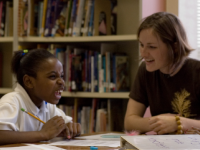Establishing a Culture of Student Voice
By co-developing classroom norms and practicing reflection and feedback, you create a culture where students want to be included because their voice matters.
Your content has been saved!
Go to My Saved Content.When I attend yoga classes, the instructor guides participants through a series of poses. An outsider unfamiliar with yoga might think the class was instructor-directed, with everyone moving through poses as they are called out. The truth is that people add or subtract movements based on their comfort, drive, and current capabilities. (My favorite is Child's Pose to catch my breath before rejoining the flow of movements.) This culture where participants shape the class along with the instructor is something I've found in every yoga class that I've attended.
Education culture can be just as powerful when students, like yoga class participants, are encouraged to help shape what and how learning takes place every day. It requires teachers to view what students can do alongside us. I already explored this in Student-Centered Learning: It Starts With the Teacher.
There are many tools for establishing a culture of student voice. Here are some that are easy to implement as you launch your students' journey.
Develop Norms Together
Norms are something different from the classroom rules that are meant to establish order. Norms provide students and teacher with a shared understanding of how they can best support each other in the learning process. Norms are behavior guides that can help the teacher and the other students in mentoring classmates who struggle with following the norms.
Norms exist whether or not they are addressed. A common unspoken norm for students is that when a teacher asks a question, if no one responds in one to three seconds, the teacher will cajole the class or answer the question him- or herself. Or maybe Sam in the front of the room will answer the question as usual. Norms go underground if students are not included in forming them. Consider these steps for creating classroom norms:
1. Students reflect and share examples of environments that they feel were positive, such as a sports team, church or scouting group, or family ritual.
2. In small groups, students unpack the examples for the behaviors that made the experience or vibe positive.
3. Use Think-Pair-Share to create a list of positive behaviors that would support a learning environment where everyone feels successful and supported.
4. Use team builders to identify behaviors. After each team builder, students reflect and share what skills were needed to be successful at the task.
5. The class collectively reduces the list to 4-7 norms, framed in positive, student-friendly language. Some examples might include:
- All voices need to be heard.
- Talk after two. (Translation: Each person must wait until two others say something before they can speak again.)
- Presume positive intent. (In student-friendly language: "Would you say that to your mother?")
Here are helpful resources for further exploration:
Practice Reflection and Feedback
Coach and provide opportunities for students to reflect and give feedback about curriculum, classroom culture, and classroom systems. Spending time on reflection and feedback sends a signal about what's valued in this academic setting. Students need airtime about how the classroom operates if we expect them to care. Once they do engage, their ideas should be implemented. Otherwise, student culture will go underground where no teacher authority can reach.
Here are strategies that promote student reflection and feedback. The key is having them share in the determination of topics as the focus.
Question Formulation Technique: Coach students on how to ask good questions and which to use depending on the circumstance and need. Use the Right Question Institute's rich resources, or start with these these articles from Opening Paths.
Morning Meeting: Dialog provides a powerful voice for students reflecting on the current climate and needs. It's also good for reviewing their shared experiences at the end of the day, or for celebrations and concerns. The experience is valuable for all ages.
Journaling: Writing reflections can be a tool for students to work through their thoughts and emotions before sharing a distillation to groups and/or the teacher.
Surveys: Individual and anonymous feedback enables students to give focused responses to classroom culture concerns. It's important to give the class opportunities for reviewing and analyzing the results together. For quick turnarounds, use social media survey tools.
Protocols for Reflection and Feedback: There are many protocols that help students work on active listening and ensure that every voice gets airtime. Using protocols creates a safe environment for students to express their thoughts and suggestions in constructive and supportive language. Some examples to explore are:
Valued Culture = Student Engagement
Students value a classroom or school culture where they feel cared about. Ask any student, "Who did you have your favorite learning experiences with?" It's always with a teacher about whom they'll eventually say, "She believed in me," or "He listened to us." When students want to spend time in a classroom after school or during lunch, something positive is going on. Using the above strategies for norms, reflection, and feedback can help create a culture where students want to be included because their voice matters.
What firmly establishes a culture of student voice is giving them charge of how they learn, including development of assessments and products for learning outcomes (the focus of my next post). It's similar to those yoga classes where participants craft their own movements that, while different from the instructor's directions, achieve the common need of maintaining the breath and self-challenge. Teachers who co-create a culture of student voice are setting the foundation for students owning their own learning.
Namaste.
